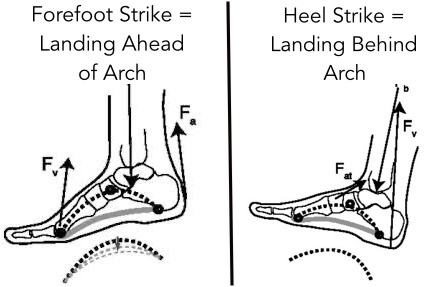Forefoot running not only takes the lead as being the safest way to run, it’s also the fastest, regardless of running distance. This means that whether sprinting or running a marathon, you will always be more economical, with a faster, more sustainable turn-over with forefoot running than heel strike running. Here’s why:

What’s more, so much of the benefits of forefoot running comes from its ability to instantly mobilize a better positioned shin, knee and upper body posture angle. This is because landing on your forefoot automatically enables your knee-joint to bend and softly flex at landing, which directly enables the foot to land closer to your upper body, while enabling your upper body to tilt slightly forward, shown below:

The hallmarks of a forefoot strike includes advancing your mechanics in critical ways that prevents the kind of impact that virtually causes most injury, and drains energy. This is because, as mentioned above, forefoot running makes more functional use of your body’s mass by keeping your entire biomechanics in a safer range, especially encouraging the entire body to fall forward due to the force of gravity. In this way, there’s significantly less demands from the muscles because the forward lean, engaged by the forefoot strike, allows gravity to pull the body down which automatically shifts the center of mass forward, which in turn, cuts down on the time spent braking with the ground and affords faster, more efficient accelerations tied to low impact.
In contrast, landing with a heel strike when running disrupts these key mechanical alignments that actually work against the force of gravity. Here’s why:

In heel strike running, the knee along with the body’s muscles are used too much to help carry the mass of the body through the long over-stride and onward. This dramatically increases muscle force generation as well as muscular strain and fatigue since these movements oppose the force of gravity. This also requires more propulsive muscle force to launch the body forward as well.
Another economic challenge of heel strike running is the foot posture at landing puts the Achilles and the arch in a difficult position, making these structures an ineffectual spring because for one, the Achilles tendon is hyper-stretched at landing, while enduring the highest loads of impact out of any other running style. In addition, landing behind the arch was found to be not nearly as effective in allowing the arch to act as an energy-saving spring vs landing ahead of the arch, as in a forefoot strike, shown below:

The Take Home Message
Good, sustainable running economy partly depends on how well your arch and Achilles tendon act as energy-saving springs, however heel strike running takes away these primary energy-saving sources. To make up the difference, the muscles perform most of the work, which requires more energy. At the same time, the excessive brake force complicates the matter by loading more compressive waves through the shin and knee. The full consequences are ongoing injury and poor performance.
Protection from impact, not with increased underfoot cushioning, but with changing your heel strike to a forefoot strike provides its own set of natural protections that are responsible for helping improve the odds of avoiding injury and even severe, long bone injuries.
It’s even better that the mechanical contributions of forefoot running does a better job at allowing the arch and Achilles to function as springs, which is what they are. Such improvement means that forefoot running engages the mechanics that perfectly matches the function of the elastic structures of the lower leg, which strongly implies that the human body was more configured for forefoot running, not heel strike running.
Need more convincing that forefoot running is safer and faster than heel strike running? Here are all the evidence-based reasons heel strike running will not help you avoid injury, no matter how thickly cushioned your running shoes are.

If you enjoyed this, you’ll love my Youtube channel, here, where I show in clear detail why forefoot running works!

References:
Chabay, RW and Sherwood, BA. Matter and Interactions 3rd Edition. John Wiley & Sons Inc.
Hasegawa, H., Yamauchi, T., & Kraemer, W. J. Foot strike patterns of runners at the 15-km point during an elite-level half marathon. J of Strength and Cond Res, 2007; 21: 888 – 893.
Kubo et al. Relationship between Achilles tendon properties and foot strike patterns in long-distance runners. J Sports Sci, 2014; 3, 1-5.
Seller et al., 2010. Evolutionary robotic approaches in primate gait analysis. Intern Journ Primat, 31(2): 321 – 338.
Larson et al.Foot strike patterns of recreational and sub-elite runners in a long-distance road
race. J of Sports Sci, 2011 29, 1665 – 1673.

Bretta Riches
BSc Neurobiology; MSc Biomechanics candidate, ultra minimalist runner & founder of RunForefoot. I was a heel striker, always injured. I was inspired by the great Tirunesh Dibaba to try forefoot running. Now, I'm injury free. This is why I launched Run Forefoot, to advocate the health & performance benefits of forefoot running and to raise awareness on the dangers of heel striking, because the world needs to know.
Latest posts by Bretta Riches (see all)
- Can You Run In Barefoot Shoes? Yes, But DON’T Heel Strike! - 21/07/2024
- Why Cushioned Running Shoes Are Really Bad for Your Feet - 19/07/2024
- Do Cushioned Running Shoes Cause Injuries? - 17/07/2024
